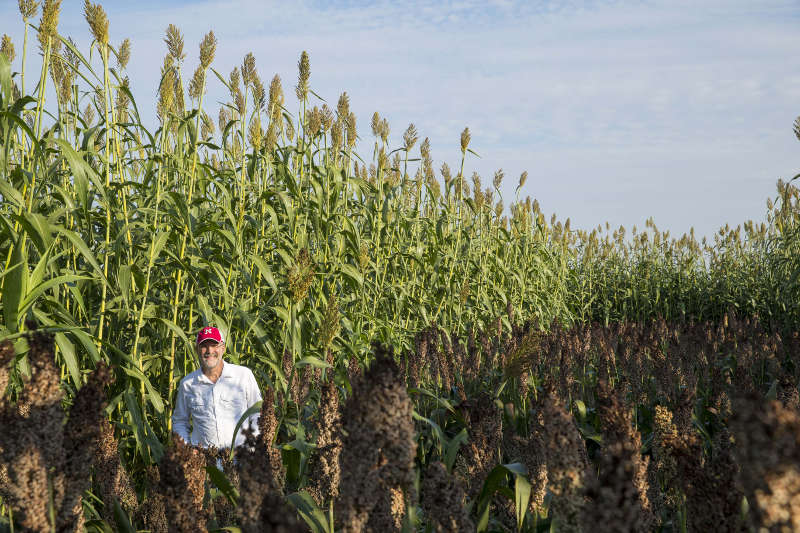Sorghum and corn seed innovations may expand opportunities.
While ethanol made from corn remains the most common biofuel produced in the United States, both public and private researchers are finding other sources — such as sorghum and corn biotech products — may offer additional efficient and economic benefits to the production process.
The University of Nebraska-Lincoln (UNL) leads a $13.5 million multi-institutional research effort to improve sorghum as a source for biofuel production. Funded by the U.S. Department of Energy (DOE), the five-year grant assesses how plants and microbes interact and which sorghum germplasm grows best with less water and nitrogen.
Daniel Schachtman, professor of agronomy and horticulture and director of UNL’s Center for Biotechnology, is leading the effort. He says sorghum is a logical choice because sorghum varieties more easily replace corn than other sources. In addition, some research suggests sorghum may create more biomass for cellulosic ethanol than corn.
“Biofuel crops must be able to be grown over a broad geography and increasingly on more marginal lands,” Schachtman says. “Sorghum handles drought well and uses less nitrogen than corn. Farmers also are familiar with sorghum as a crop and have the equipment and seed availability to meet industry demand over feedstocks like switchgrass or miscanthus.”
Schachtman says the ultimate goal of the two-prong approach of studying plant genetics and soil microbes is to get a sustainable system in place for sorghum’s use in biofuels. Geneticists are searching for varieties that use water and nitrogen more efficiently under limited water or nitrogen conditions. Microbiologists are identifying and characterizing soil microbes that benefit sorghum by enhancing nutrient uptake, water-use efficiency and disease protection.
“We hope to map traits like drought and nitrogen use efficiency, identify genes and use markers to breed sorghum so we can put together a plant that creates a better and higher yielding biomass under marginal conditions,” he says. “Then we will experiment to find the genetic and microbial combinations with the greatest productivity benefits and develop a repository of sorghum-related soil microbes and their genetic sequences as a resource for use by the scientific community.”
So far, Schachtman says the main finding has been confirming that sorghum has a very diverse crop range of tolerance to low nitrogen. Researchers grew 10 diverse genotypes this summer, and now are choosing parents for mapping the traits.
“Because of the diversity, we are confident we will find the right genetics,” he says. “We have a dream team working on this project. The result will be improved sorghum genetic material for stress tolerance and a microbial cocktail that we can coat on the seeds for further enhancement.”
Other institutions involved are the Donald Danforth Plant Science Center, Washington State University, University of North Carolina at Chapel Hill, Boyce Thompson Institute, Clemson University, Iowa State University, Colorado State University and the DOE-Joint Genome Institute.
“Marrying seed treatments with microbes is an exciting area for future optimization, and it is the potential next step to delivering a biofuels solution with sorghum,” he adds.
Corn Enzyme Improves Processing
While the public sorghum research project is about creating a seed product from traditional breeding methods, one company has developed a biotech corn product that enhances the ethanol production process. Syngenta’s Enogen corn enzyme technology was developed a decade ago and has been on the market since 2011. Syngenta not only markets Enogen hybrids, but it also has established a management practices program for farmers growing corn for ethanol plants and is licensing a new technology to maximize ethanol plant production.
“Enogen was specifically designed to enhance ethanol production,” says Chris Tingle, head of commercial operations for Enogen at Syngenta. “Enogen contains an alpha amylase enzyme, as expressed in the corn kernel, which allows ethanol plants to reduce the viscosity of corn mash and eliminate the need to add a liquid form of the enzyme. Amylase enzyme withstands temperatures to break down cellulose into sugars. Compared to other enzyme technology, it can increase production from the same amount of corn. It also reduces ethanol plant energy use.”
Since ethanol consumes about 40 percent of the annual U.S. corn crop, Enogen hybrids are being grown from Ohio to North Dakota and south to the Kansas/Oklahoma border.
“We put the technology into our higher trait and elite germplasm offerings, so more local corn growers can supply their local ethanol plants,” Tingle says. “Syngenta is currently working with more than 20 plants. While there is no difference in the agronomic management compared with any other corn, it is an identity-preserved crop. Growers are eligible for up to a 40-cent premium.”
In addition to its Enogen offering, Syngenta has also developed its Ethanol Grower Advantage program to help farmers maximize return on investment on ethanol acres. And Syngenta is working with ethanol plants to maximize output from their production processes. Cellerate, a revolutionary process technology, converts corn kernel fiber into cellulosic ethanol and can help plants produce more ethanol from the same kernel of corn.
“Cellerate is a technology for dry grind plants. It improves fermentation, and can help plants produce more ethanol from an existing asset base. It also increases total yield of distillers grains corn oil and improves the protein content of feed co-products,” he says. “Corn kernel fiber is leading the way to the development of cellulosic fuels.”
Developed at Quad County Corn Processors (QCCP), Cellerate is an alliance between Syngenta and Cellulosic Ethanol Technologies, LLC, a wholly-owned subsidiary of QCCP. Head Engineer Travis Brotherson reports a 26 percent increase in ethanol production in a recent trial, achieved by realizing an additional 6 percent yield per bushel from converting kernel fiber into cellulosic ethanol and a 20 percent throughput increase combining Cellerate with Enogen.
“These results, and our experience of the past two years, confirm the consistent performance benefits available through Cellerate enhanced by Enogen, and we believe the potential could be even greater,” he says.
—By Barb Anderson











